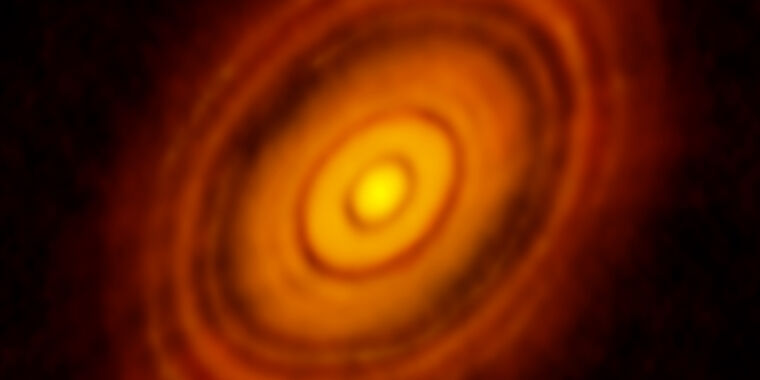Where do planets come from? The entire process can get complicated. Planetary embryos sometimes run into obstacles to growth that leave them as asteroids or naked planetary cores. But at least one question about planetary formation has finally been answered—how they get their water.
For decades, planetary formation theories kept suggesting that planets receive water from ice-covered fragments of rock that form in the frigid outer reaches of protoplanetary disks, where light and heat from the emerging system’s star lacks the intensity to melt the ice. As friction from the gas and dust of the disk moves these pebbles inward toward the star, they bring water and other ices to planets after crossing the snow line, where things warm up enough that the ice sublimates and releases huge amounts of water vapor. This was all hypothesized until now.
NASA’s James Webb Telescope has now observed groundbreaking evidence of these ideas as it imaged four young protoplanetary disks.The telescope used its Medium-Resolution Spectrometer (MRS) of Webb’s Mid-Infrared Instrument (MIRI) to gather this data, because it is especially sensitive to water vapor. Webb found that in two of these disks, massive amounts of cold water vapor appeared past the snow line, confirming that ice sublimating from frozen pebbles can indeed deliver water to planets like ours.
On the edge
Webb had its proverbial eye on four protoplanetary disks that were only around 2 or 3 million years old and forming around Sun-like stars. Out of these disks, two were compact, while the other two were larger, and had multiple gaps interrupting the disk. The research team behind this investigation wanted to see whether water was brought to the inner disk through the sublimation of ice on pebbles that drifted inward from the edges of a disk. They were also trying to make out whether this happened more efficiently in compact or larger disks.
Past studies done with NASA’s Spitzer Space Telescope and ALMA had found some data suggesting that pebble drift from the outer to the inner parts of a disk, along with subsequent vaporization of ice, was possible. Unfortunately, the data was unclear because of its low resolution; spectral lines that identified the presence of water were blurred. Webb’s higher resolution was able to separate these lines so they were much more distinct and showed the spectra of warm and cool water.
The Webb researchers were looking for cool water, which would indicate sublimated ice that confirmed previous ideas of frozen pebble drift. Warm water in a disk could only go so far as evidence, as it would probably mean that drift and sublimation had already happened, and the water vapor that resulted had now been heated by the nascent planetary system’s star.
From pebble to planet
In the two larger disks, it was found that frozen pebbles in larger systems have a hard time getting through the gaps. They are often caught up with other materials floating around in a gap and remain stuck there instead of continuing to drift inward. They also tend to encounter pressure traps, or regions of increased pressure that cause them to accumulate, which does not completely prevent them from drifting but acts as a cosmic speed bump. While there was some cool water vapor detected in these disks, there was not the large amount of vapor at the snow line that the team was looking for.
Observations of the compact disks were a breakthrough. The data Webb beamed back showed that, while there were spectra suggesting the presence of warmer water vapor emissions far inside the disk, there was also an excess of cold water vapor emissions just on the outside of the snow line. It is from here that the water vapor will travel to the inner parts of the disk.
“Pebble drift and trapping provide a fundamental, natural process for a large-scale link between inner and outer disk regions that may explain the cool water excess revealed by MIRI in the compact disks analyzed in this work,” the researchers said in a study recently published in The Astrophysical Journal Letters.
So what happens from there? Eventually, drifting pebbles that lack ice will collide with each other until they begin to accrete into what might eventually become a planet. That hypothetical planet may later be supplied with water vapor, and billions of years from now, it could even become another Earth. Maybe analogs to our planet really are out there. They just might not have formed yet.
Astrophysical Journal Letters, 2023. DOI: 10.3847/2041-8213/acf5ec

Dr. Thomas Hughes is a UK-based scientist and science communicator who makes complex topics accessible to readers. His articles explore breakthroughs in various scientific disciplines, from space exploration to cutting-edge research.








